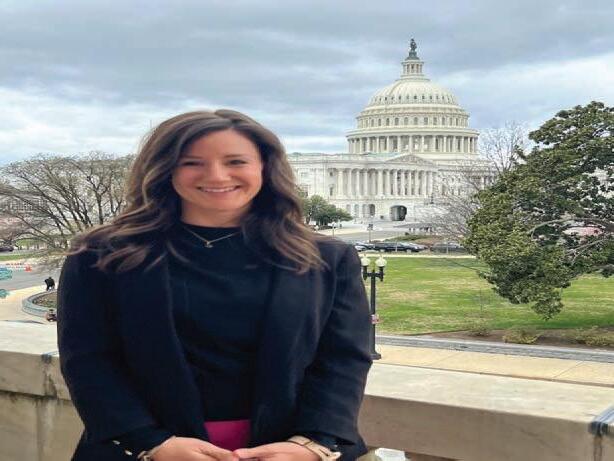
4 minute read
Bortz inducted into Women’s Hall of Fame Reflects on courage, career, community
BY NINA JOSS
NJOSS@COLORADOCOMMUNITYMEDIA.COM

When Libby Bortz left her home for college, her parents told her it was important to have an educated heart, not just an educated mind.
“When you can feel with people and you know what it feels like to be in their shoes — that, for me, is kind of what an educated heart is about,” Bortz said. “It means that you think beyond yourself and you take into account other people’s needs, not just your own.”
For Bortz, an educated heart was the motivator behind much of her work in Littleton, where she made a di erence in the community through counseling, housing, education civil rights and criminal justice.
Bortz was one of 17 trailblazing women inducted into the Colorado Women’s Hall of Fame at the annual
Federal funding
Congress dropped billions in COVID relief from its spending bill in 2022, including money that allowed schools to o er free meals to all students during the pandemic. At that time, Gould and her colleagues across the country worried how they would continue to provide food for the clearly massive need in their communities.
Right in the nick of time, the federal government made a move to continue support to schools’ nutrition programs for the next year.
“At the very last minute - I mean, very last minute - the Keep Kids Fed Act funding… came through for us, which was very instrumental and, in all honesty, like critical for us to keep maintaining our budget,” Gould said.

e Keep Kids Fed Act of 2022 increased the federal funding reimbursement for school lunches and breakfasts.
is July, the funding will end unless it is extended.
In D.C., Gould and her colleagues urged lawmakers to make permanent the funding increases from the Keep Kids Fed Act.
In ation, supply shortages and higher salaries to combat labor shortages have dramatically increased costs for school food programs, according to the SNA. A recent survey by the group showed that 99.8% of school nutrition director respondents are challenged by increasing costs.
“ e way that the regulations are written, we are pretty tied to that reimbursement, that it is a very speci c equation” Gould said. “And it just is not enough right now for us to maintain our program and the integrity of our programs…. What gets cut, you know? Do you cut on professional development for the team? Do you cut on food quality?”
Gould said two bills in Congress propose extending the Keep Kids Fed Act or permanently funding school nutrition programs.
Healthy school meals for all
In November, almost 57% of Colorado voters supported a proposition to provide a universal free school meal program at districts in the state. is program, called Healthy School Meals for All, will start in Littleton in August.
During their legislative action conference, Gould and her colleagues advocated for the federal government to implement a program like this in all states.
“A student that’s hungry in Colorado is no di erent than a student that’s hungry in Nebraska,” Gould said. “I think as a global perspective, just wanting that same bene t for all kids is important.” anks to support from the Littleton Public Schools Foundation, negative balances will be wiped clean in the district before the Healthy School Meals for All program begins next school year, Gould said.
Since meal waivers from the pandemic expired, California and Maine have continued free meals in their states, according to the SNA. But most school meal programs in the country require families to complete free and reduced-price applications.
“If you make $51,400 as a family of four, you don’t qualify (for free and reduced meals in Littleton),” Gould said.
For this reason, families in Littleton and across the country build up negative balances within school meal systems. SNA reported that many schools must cut into other funds to cover the debt.
“As we move into next year, no family will then have to worry about the balance that they previously had or any of that and then all kids will be able to eat for free,” she said.
It’s unlikely the national government will start a program for free meals for all states this year, Gould said, but it’s worth taking steps towards the goal.
Pause additional nutrition standards
Gould said the U.S. Department of Agriculture recently rolled out proposed nutrition standards that would call for further reductions in sodium and sugar, starting in the 2024-2025 school year.
In D.C., she and other advocates called on lawmakers to ensure the USDA maintains current school nutrition standards, rather than implementing “additional, unachievable rules,” according to the SNA.

Schools plan menus a year or more ahead of time, Gould said. Expecting schools to meet new nu- trition standards by the 2024-2025 school year doesn’t provide enough time for them to conduct taste testing to ensure the meals are desirable in student’s eyes.
“It’s very proven that no matter how hungry some kids are, if (food) tastes horrible, they will not eat it,” Gould said. “We want to make sure it’s nutritious and that it is actually palatable.”
In addition, many manufacturers don’t o er products that would meet the new reductions in sodium and sugar.
“We are asking for more of a conversation about what the rollout looks like, so that we don’t need to start those rollouts (in the 20242025 school year),” Gould said. “And/or if we do, that it’s less of an aggressive rollout.”
Gould understands the intention of the proposed nutrition standards, but said schools have been working towards healthy meals with lower sodium and more fruits and vegetables for many years. She said educating families and students on nutrition and how to implement it in a healthy lifestyle is the next crucial step.
“To me, that’s a little bit more of what we need to be doing right now,” she said. “So that… as we do continue to increase the nutritional quality of the items that we’re providing, it sticks because they understand why they’re doing it too -- we’re not just doing it behind the scenes and they have no idea what’s happening”
Advocates also asked Congress to reduce regulatory and administrative burdens so nutrition providers can better put time and resources towards serving students.
As Littleton Public School looks forward to beginning the Healthy School Meals for All program, Gould said her team needs to hire about 25 more sta members to meet the higher participation.
“Every initiative that we want to do will fall short if we don’t have the people to help do it,” she said. “it really is like the most amazing job because you’re working your student’s schedule. ere’s a lot of bene ts -- I think people kind of forget that they’re out there.”
Interested applicants can nd more information and apply on the district’s website at https://littletonpublicschools.net/apply-now-openpositions.
















